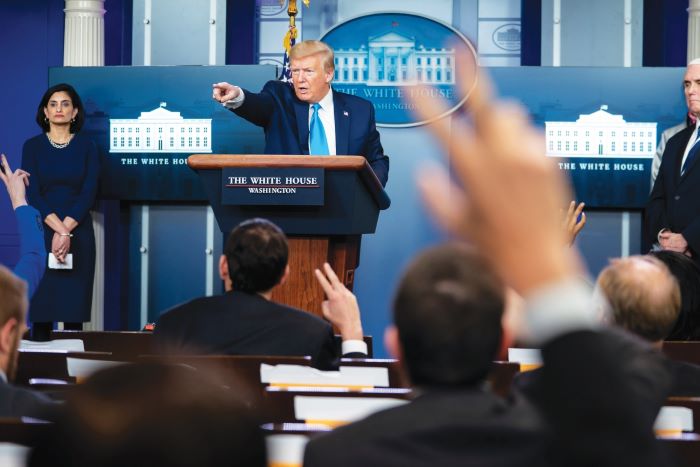Just by looking outside at deserted freeways and shuttered businesses, it’s clear that most Americans are abiding by the stay-at-home policies still in effect across much of the nation. And in the age of online shopping, many are fortunate enough to weather the pandemic from the comfort of their couches, buying everything from workout equipment to prescription medications and essential groceries directly from an app or website. Instacart, a service that manages grocery deliveries and pickups in Canada and the United States, reported a 150 percent jump in orders during the pandemic’s early days.
But all of those purchases add up to a massive amount of packages, and our local delivery men and women have become some of the pandemic’s unlikely heroes as a result. For those of us waiting at home, pressing the Check Out button sets into motion a huge shipping supply chain that stretches from the original suppliers, to different freight stations, to the postal workers who eventually place that package on our doorsteps.
N. Giang has worked as a carrier technician with the United States Postal Service in Southern California for the past 30 years. Initially, he explains, nobody in his area envisioned the true threat posed by a COVID-19 outbreak. “We thought it would probably go away like any other normal flu,” Giang says. “It wasn’t until more people started getting infected that we immediately knew it was becoming a serious issue.”
Giang, who mainly works with letters, goes on to note that while the volume of regular mail has been relatively slow, the amount of parcels has exponentially increased, as can be expected of a now-homebound nation. The USPS has stated that customers should be prepared for slower delivery rates than normal, as their system struggles to keep up with the influx of orders.
Halfway across the country, H. Nguyen, who works as a regular rural carrier for the USPS in Oklahoma, says that an overall lack of manpower might be partially to blame. “As far as the post office goes, it’s operations as usual. They don’t allow us to do much else,” he says. “They claim they want to hire more people, but in this environment, how are you going to do that without coming into contact with the person directly? Everything is online, buying’s online, doctors are even treating patients online. So how in the world do you actually hire these people and have them trained?”
Even more concerning is the nationwide lack of proper protective gear for the employees who are coming in to work every day and risking infection as they handle packages that have already been processed by numerous other hands. “We’re still required to come in as we always have,” Nguyen says. “They have spoken to us about distancing ourselves, but in reality, the post office is just terrible. We have no gloves, no hand sanitizer, no masks, nothing. They tell us the virus doesn’t last long on surfaces without biological hosts, but you don’t know. They don’t know.”
Instead, many carriers are expected to purchase their own protective gear—if they can find it. Although the postal service has taken some preventive measures, like requiring verbal confirmation of package delivery rather than a written signature, these efforts offer scant comfort for worried deliverers. “Business Insider” reports that, as of March 25, nearly 2,000 USPS workers were in quarantine, and 51 had tested positive for the virus. In fact, an employee at a station near Nguyen’s had recently been diagnosed. But these numbers are difficult to keep up with, as several states don’t publicly release their numbers of infected USPS employees.
Unfortunately, these aren’t the only troubles afflicting the postal service. “The sales are down,” Giang says. “Mail is very light, except for parcel increases. Everyone is scared because we might possibly close down. We’re almost running out of money because the revenue is taking a steep dive.”
While some grateful customers have created care packages for overworked deliverers, the USPS has met with a far less appreciative response from the federal government. A potential $10 billion emergency loan was blocked by President Donald Trump, who confirmed on April 24 that he was barring that aid unless the postal service considers making significant changes to its structure and management. Those alterations, according to a report from the “Washington Post,” include shifting much of the oversight of the USPS to the U.S. Treasury Department and upping postage prices by four times their current amounts. Without that loan, though, the postal service faces bankruptcy.
Even with the industry facing such a grim future, delivery men and women continue to report to work across the country, making sure our mail still arrives. But on a day-to-day level, it’s hard not to see the glaring lack of protection afforded to these essential workers. “[The USPS] should be more active in what they do as far as preventive equipment, instead of just words,” Nguyen says. “Eventually, if the plant workers and the carriers get infected and pass it around, we’re going to have a real shortage of people who know what they’re doing, and it takes a long time to train somebody to actually take the mail, sort the mail, deliver the mail. So unless they do something, I don’t see a good future for it.”
This article appeared in “Character Media”’s April/May 2020 issue. Check out our current e-magazine here.







